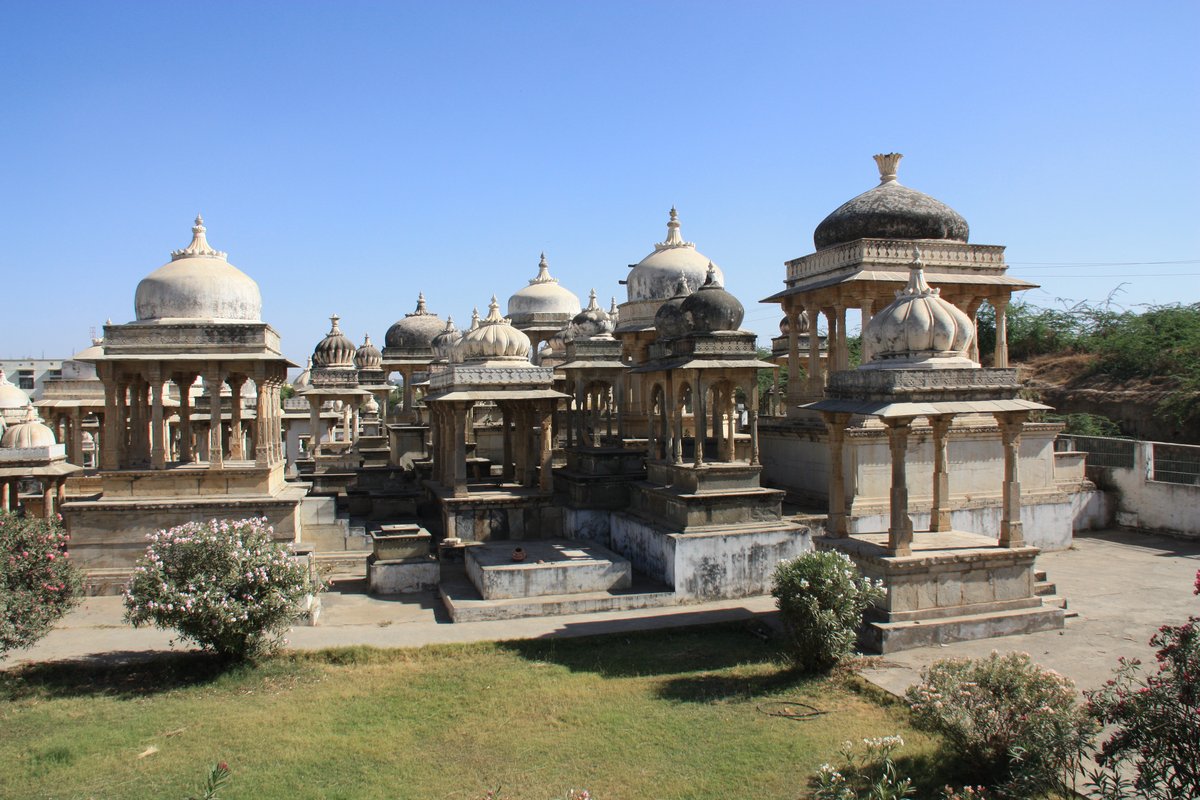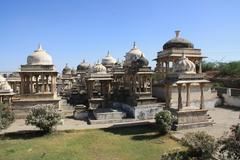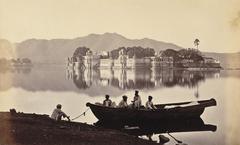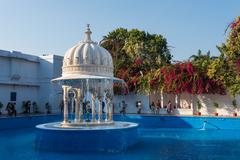
Ahar Cenotaphs Visiting Hours, Tickets, and Complete Guide to Udaipur’s Historical Sites
Date: 14/06/2025
Introduction
Nestled just a few kilometers east of Udaipur’s bustling city center, the Ahar Cenotaphs—also known as “Mahasati”—stand as a striking testament to the royal legacy and architectural prowess of Rajasthan’s Mewar dynasty. This remarkable complex, dating back to the 10th century, serves as the royal cremation ground for one of India’s oldest dynasties. With over 250 intricately carved marble cenotaphs (chhatris), the site commemorates the valor and leadership of Mewar’s Maharanas, queens, and royal kin. The blend of Hindu and Jain architectural influences, evident in the domed pavilions and ornate pillars, highlights the spiritual and cultural significance of the site (TravelTriangle, UdaipurTourism, VisitPlacesIndia).
Visitors are treated to a serene environment set amid landscaped gardens, where centuries-old funerary traditions—including the now-outlawed practice of sati—are memorialized in stone. The adjacent Ahar Archaeological Museum further enhances the experience by displaying artifacts from the Chalcolithic era, offering a deeper understanding of the region’s ancient heritage.
This comprehensive guide details everything you need to know for an enriching visit: from historical context and architectural highlights to practical information on visiting hours, ticketing, accessibility, and nearby Udaipur attractions.
Table of Contents
- Historical and Cultural Overview
- Architectural Features and Symbolism
- Role as a Royal Cremation Ground
- Visitor Information
- Site Layout and Facilities
- What to Expect During Your Visit
- Practical Travel Tips
- Nearby Udaipur Historical Sites
- FAQs
- Summary and Final Tips
- References
Historical and Cultural Overview
The Ahar Cenotaphs represent over a millennium of royal funerary tradition. Archaeological evidence suggests Ahar has been inhabited for more than 4,000 years, with the cenotaphs themselves originating in the 10th century. The tradition of constructing these memorials became prominent with Maharana Amar Singh I’s cremation in 1620, and the site remained in active use until the 21st century (UdaipurTourism). Their continued use underscores the enduring importance of Ahar as a sacred site for the Mewar dynasty.
The cenotaphs reflect Rajput values of bravery, loyalty, and sacrifice, with many carvings and inscriptions offering a window into the customs and histories of Mewar royalty. The outlawed practice of sati is also memorialized here, marking the site as both a place of reverence and reflection.
Architectural Features and Symbolism
Ahar’s more than 250 marble cenotaphs showcase classic Rajasthani architecture, featuring domed chhatris on carved pillars, octagonal domes, and temple-inspired embellishments. Nineteen principal chhatris honor individual rulers, while others commemorate queens and royal family members. Ornamental details such as lotus motifs, jali (lattice) work, and depictions of Hindu deities like Vishnu and Shiva adorn the structures, highlighting both religious and artistic influences (VisitPlacesIndia).
Jain architectural influence is evident in the symmetry and geometric patterns, especially in the domes and parapets. The white marble, sourced locally, glows under the Rajasthani sun, creating a striking contrast with the lush gardens and blue sky.
Role as a Royal Cremation Ground
Known as “Mahasati” or the “Great Place of Sati,” Ahar served as the cremation site for nineteen Mewar rulers along with their families. Stone effigies and inscriptions commemorate the queens who performed sati, immortalizing their devotion and sacrifice. This tradition, while no longer practiced, is a significant part of the site’s history (TravelSetu).
The site continues to be respected by the Mewar royal family, with recent cremations reflecting the continuity of royal traditions.
Visitor Information
Visiting Hours & Entry Fees
- Cenotaph Complex: Open daily from 6:00 am to 6:00 pm (Our Taste for Life).
- Ahar Archaeological Museum: Adjacent to the cenotaphs, open from 10:00 am to 4:30 pm (closed Fridays and government holidays).
- Entry Fees: No official ticket is required for the cenotaphs. The museum charges a nominal fee (approx. 3 INR). Occasionally, unofficial photography fees may be requested, which are optional.
Accessibility
- Terrain: Paths are mostly flat but uneven in places, presenting challenges for wheelchair users or those with limited mobility.
- Assistance: Minimal on-site facilities; assistance can be requested at the entrance.
How to Reach
- Taxi/Auto-Rickshaw: 10–15 minutes from Udaipur city center (Udaipur Darpan).
- Rentals: Scooter or bicycle rentals are available for confident riders.
- Walking: About 30–40 minutes from the city center, best attempted during cooler hours.
Best Time to Visit
- October to March: Pleasant weather, ideal for exploring and photography.
- April to June: Very hot; avoid midday visits.
- July to September: Monsoon brings lush surroundings but also rain.
Guided Tours and Etiquette
- Local guides are available on-site and can provide valuable historical insights.
- Book tours in advance for a richer experience.
- Maintain respectful conduct—avoid loud conversation, do not climb monuments, and remove shoes where required.
- Photography is permitted; be mindful of the site’s solemnity.
Site Layout and Facilities
The cenotaphs are set within a walled, landscaped garden. Larger, more elaborate chhatris are dedicated to prominent rulers, while smaller ones honor other royal family members. Water channels and shaded areas enhance the tranquil atmosphere. Basic facilities are provided; there are limited restrooms and no on-site cafes, so carry water and snacks.
What to Expect During Your Visit
- Atmosphere: The site offers a peaceful retreat from city crowds, ideal for quiet reflection and photography (Travejar).
- Duration: Most visitors spend 1–2 hours exploring both the cenotaphs and the museum.
- Highlights: Marvel at the detailed marble carvings, historical inscriptions, and the serene environment.
Practical Travel Tips
- Wear comfortable shoes and modest, weather-appropriate clothing.
- Visit early morning or late afternoon for best lighting and cooler temperatures.
- Carry essentials such as water, sunscreen, and a camera.
- Be wary of unofficial guides or requests for extra fees.
- Supervise children due to uneven terrain and the delicate nature of the monuments.
Nearby Udaipur Historical Sites
Enhance your visit by exploring these nearby attractions:
- City Palace: Iconic Rajasthani architecture and museums (Holidify).
- Lake Pichola & Jag Mandir: Scenic boat rides and lakeside palaces.
- Saheliyon-ki-Bari: Beautiful gardens with fountains and lotus pools.
- Bagore Ki Haveli: Museum with evening cultural performances.
- Sajjangarh Palace (Monsoon Palace): Hilltop palace with panoramic views (TripXL).
- Ahar Archaeological Museum: On-site, featuring regional artifacts.
- Vintage Car Museum, Bohra Ganesh Temple, Neemach Mata Temple, Bharatiya Lok Kala Mandal, Gulab Bagh, and Ambrai Ghat are all within a short drive and offer diverse cultural experiences (Udaipur Darpan).
Frequently Asked Questions (FAQs)
Q: Do I need a ticket to visit the Ahar Cenotaphs?
A: Entry is free; the adjacent museum has a nominal fee.
Q: What are the visiting hours?
A: The cenotaphs are open daily from 6:00 am to 6:00 pm; the museum is open 10:00 am to 4:30 pm (closed Fridays and government holidays).
Q: Is the site accessible for visitors with disabilities?
A: Accessibility is limited due to uneven terrain; assistance is recommended.
Q: Is photography allowed?
A: Yes, but you may be asked for an optional, unofficial fee. Always be respectful.
Q: Are guided tours available?
A: Yes, guides can be arranged locally or in advance.
Q: When is the best time to visit?
A: October to March is most comfortable for outdoor exploration.
Summary and Final Tips
The Ahar Cenotaphs offer a captivating blend of history, architectural splendor, and cultural reverence—a true window into the Mewar dynasty’s legacy. Their proximity to other iconic Udaipur sites, free entry, and tranquil setting make them a must-visit on any Rajasthan itinerary. For the best experience, plan your visit during the cooler months, consider hiring a knowledgeable guide, and combine your trip with nearby attractions.
To enrich your journey, download the Audiala app for detailed guides, ticketing support, and exclusive tours. Stay updated by following official tourism channels and our social media for the latest travel insights.
References
- Ahar Cenotaphs Udaipur: Visiting Hours, Tickets & Historical Guide, 2025, TravelTriangle
- Ahar Cenotaphs Udaipur, 2025, UdaipurTourism
- Ahar Cenotaphs in Udaipur: Visiting Hours, Tickets, and Architectural Highlights, 2025, VisitPlacesIndia
- Ahar Cenotaphs Udaipur: Visiting Hours, Tickets & Guide to Udaipur Historical Sites, 2025, Our Taste for Life
- Ahar Cenotaphs Udaipur, Udaipur Darpan
- Ahar Cenotaphs Wikipedia
- City Palace, Udaipur, Holidify
- Laure Wanders: Ahar Cenotaphs Udaipur
- Travejar: Ahar Cenotaphs
- TripXL: Udaipur Attractions



